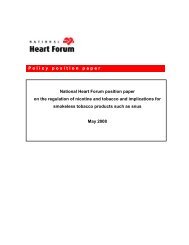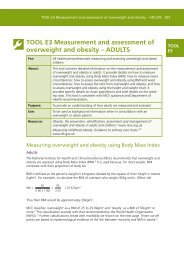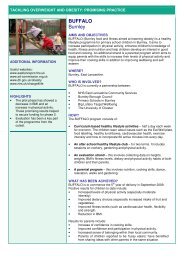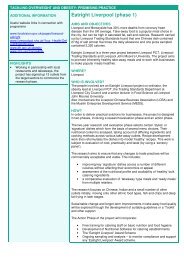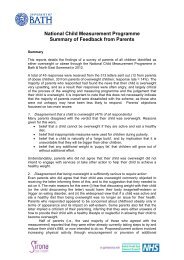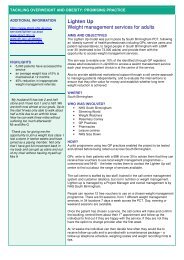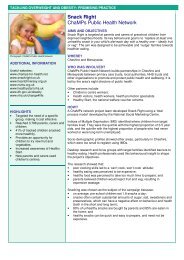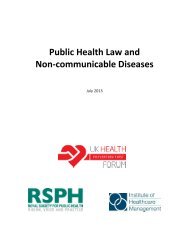The Challenge of Non-Communicable Diseases and Road Traffic ...
The Challenge of Non-Communicable Diseases and Road Traffic ...
The Challenge of Non-Communicable Diseases and Road Traffic ...
You also want an ePaper? Increase the reach of your titles
YUMPU automatically turns print PDFs into web optimized ePapers that Google loves.
An Overview 17<br />
FIGURE 7: ASMR by NCD Cause, WHO Regions, 2008<br />
Age-st<strong>and</strong>ardized adult mortality rate by cause<br />
(ages 30-70 years per 100,000 population)<br />
2000<br />
1800<br />
1600<br />
1400<br />
1200<br />
1000<br />
800<br />
600<br />
400<br />
200<br />
0<br />
All Causes Cancer Cardiovascular Disease <strong>and</strong> Diabetes Chronic Respiratory Conditions<br />
Africa Americas South-East Asia Europe Eastern Mediterranean Western Pacific<br />
Source: [32]<br />
Cancers<br />
<strong>The</strong> burden from cancer is expected to more than<br />
double between 2008 <strong>and</strong> 2030, with new cases rising<br />
from 681,000 to 1.6 million <strong>and</strong> deaths rising<br />
from 512,000 to 1.2 million over that period [6].<br />
Risk factors for cancer can be infectious <strong>and</strong>/or non<br />
-infectious (Table 3). <strong>The</strong> most common cancers for<br />
men in Africa are HIV-associated Kaposi’s sarcoma,<br />
<strong>and</strong> cancer <strong>of</strong> the liver, prostate, <strong>and</strong> bladder; <strong>and</strong> for<br />
women they are cancer <strong>of</strong> the cervix, breast, Kaposi’s<br />
WHO Region<br />
sarcoma, <strong>and</strong> cancer <strong>of</strong> the liver. <strong>The</strong> lifetime risk <strong>of</strong><br />
cancer in females (0-64 years) in Africa is only 30<br />
percent lower than the risk in developed countries<br />
but their risk <strong>of</strong> dying is almost twice as high [41].<br />
<strong>The</strong> regions in the world with the highest risk for<br />
cervical cancer are Western <strong>and</strong> Eastern Africa [42].<br />
<strong>The</strong> growing use <strong>of</strong> tobacco <strong>and</strong> occupational <strong>and</strong><br />
environmental risks such as air pollution <strong>and</strong> exposure<br />
in mining, add to the cancer burden [43-44].<br />
TABLE 3: Common Cancers in SSA: Infectious <strong>and</strong> Other Risk Factors<br />
Cancer sites, in rank<br />
order <strong>of</strong> incidence<br />
Breast<br />
Infectious<br />
agents<br />
Other risk factors <strong>of</strong> high<br />
public health relevance<br />
Hormonal/reproductive factors, obesity,<br />
physical inactivity, alcohol<br />
Cervix HPV Tobacco<br />
Liver<br />
HBV, HCV<br />
Aflatoxins (produced by Aspergillus moulds),<br />
alcohol<br />
Prostate<br />
Lymphomas<br />
(non-Hodgkin <strong>and</strong> Burkitt)<br />
Colon <strong>and</strong> rectum<br />
Kaposi sarcoma<br />
Oesophagus<br />
Lung<br />
EBV, malaria,<br />
HIV (indirect), HCV<br />
Diet, obesity, physical inactivity, alcohol, tobacco<br />
HIV (indirect), HHV8<br />
Tobacco, alcohol<br />
Tobacco<br />
Helicobacter pylori<br />
Diets low in fruit <strong>and</strong> vegetables <strong>and</strong> high in salt,<br />
Stomach<br />
(bacterium)<br />
tobacco<br />
Bladder Schistosoma haematobium (fluke) Tobacco, occupational exposure<br />
Source: Adapted from [27, 44]<br />
Abbreviations: HPV Human papilloma virus; EBV Epstein-Barr virus; HBV hepatitis B virus; HCV hepatitis C virus; HHV8 human herpes virus 8.



